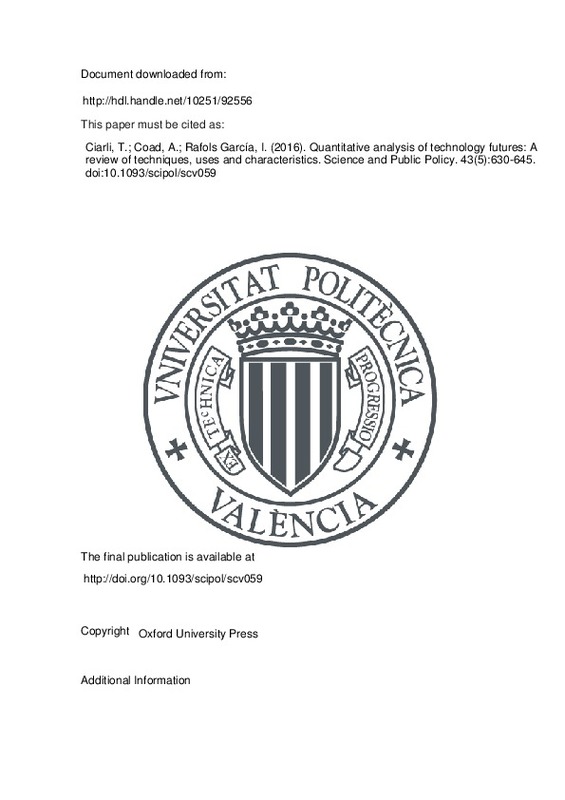JavaScript is disabled for your browser. Some features of this site may not work without it.
Buscar en RiuNet
Listar
Mi cuenta
Estadísticas
Ayuda RiuNet
Admin. UPV
Quantitative analysis of technology futures: A review of techniques, uses and characteristics
Mostrar el registro sencillo del ítem
Ficheros en el ítem
| dc.contributor.author | Ciarli, Tommaso
|
es_ES |
| dc.contributor.author | Coad, Alex
|
es_ES |
| dc.contributor.author | Rafols García, Ismael
|
es_ES |
| dc.date.accessioned | 2017-12-12T13:07:54Z | |
| dc.date.available | 2017-12-12T13:07:54Z | |
| dc.date.issued | 2016 | es_ES |
| dc.identifier.issn | 0302-3427 | es_ES |
| dc.identifier.uri | http://hdl.handle.net/10251/92556 | |
| dc.description.abstract | [EN] A variety of quantitative techniques have been used in the past in future-oriented technology analysis (FTA). In recent years, increased computational power and data availability have led to the emergence of new techniques that are potentially useful for foresight and forecasting. As a result, there are now many techniques that might be used in FTA exercises. This paper reviews and qualifies quantitative methods for FTA in order to help users to make choices among alternative techniques, including new techniques that have not yet been integrated into the FTA literature and practice. We first provide a working definition of FTA and discuss its role, uses, and popularity over recent decades. Second, we select the most important quantitative FTA techniques, discuss their main contexts and uses, and classify them into groups with common characteristics, positioning them along key dimensions: descriptive/prescriptive, extrapolative/normative, data gathering/inference, and forecasting/foresight. | es_ES |
| dc.description.sponsorship | We have benefited from comments on a preliminary draft of this paper from Jessica Bland, Michael Hopkins, Ben Martin, Rafael Ramirez and Andy Stirling. We are indebted to Alan Porter for his thorough review, which helped to improve the paper. We are grateful to two anonyous reviewers for insightful comments and to the SPP editor. All errors and omissions are our own responsibility. A first report form of this paper was prepared as part of the project financed by Nesta on 'Research into the quantitative Analysis of Technology Futures'. We acknowledge further support from the US National Science Foundation (Award No. 1064146 'Revealing Innovation Pathways: Hybrid Science Maps for Technology Assessment and Foresight'). The findings and observations contained in this paper are those of the authors, do not necessarily reflect the views of the US National Science Foundation, and may not in any circumstances be regarded as stating an official position of the European Commission. | es_ES |
| dc.language | Inglés | es_ES |
| dc.publisher | Oxford University Press | es_ES |
| dc.relation.ispartof | Science and Public Policy | es_ES |
| dc.rights | Reserva de todos los derechos | es_ES |
| dc.subject | Future-oriented technology analysis | es_ES |
| dc.subject | Quantitative techniques | es_ES |
| dc.subject | Foresight | es_ES |
| dc.subject | Forecasting | es_ES |
| dc.title | Quantitative analysis of technology futures: A review of techniques, uses and characteristics | es_ES |
| dc.type | Artículo | es_ES |
| dc.identifier.doi | 10.1093/scipol/scv059 | es_ES |
| dc.relation.projectID | info:eu-repo/grantAgreement/NSF//1064146/US/TLS: Revealing Innovation Pathways/ | es_ES |
| dc.rights.accessRights | Abierto | es_ES |
| dc.date.embargoEndDate | 2018-10-31 | es_ES |
| dc.contributor.affiliation | Universitat Politècnica de València. Instituto de Gestión de la Innovación y del Conocimiento - Institut de Gestió de la Innovació i del Coneixement | es_ES |
| dc.description.bibliographicCitation | Ciarli, T.; Coad, A.; Rafols García, I. (2016). Quantitative analysis of technology futures: A review of techniques, uses and characteristics. Science and Public Policy. 43(5):630-645. doi:10.1093/scipol/scv059 | es_ES |
| dc.description.accrualMethod | S | es_ES |
| dc.relation.publisherversion | http://doi.org/10.1093/scipol/scv059 | es_ES |
| dc.description.upvformatpinicio | 630 | es_ES |
| dc.description.upvformatpfin | 645 | es_ES |
| dc.type.version | info:eu-repo/semantics/publishedVersion | es_ES |
| dc.description.volume | 43 | es_ES |
| dc.description.issue | 5 | es_ES |
| dc.relation.pasarela | S\334536 | es_ES |
| dc.contributor.funder | National Science Foundation, EEUU |







![[Cerrado]](/themes/UPV/images/candado.png)

